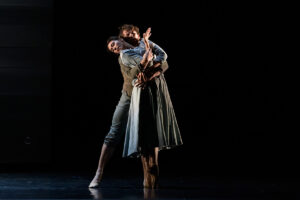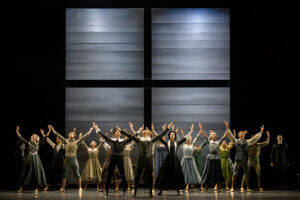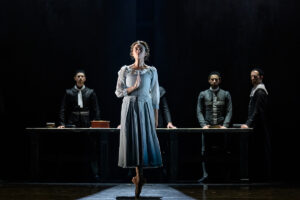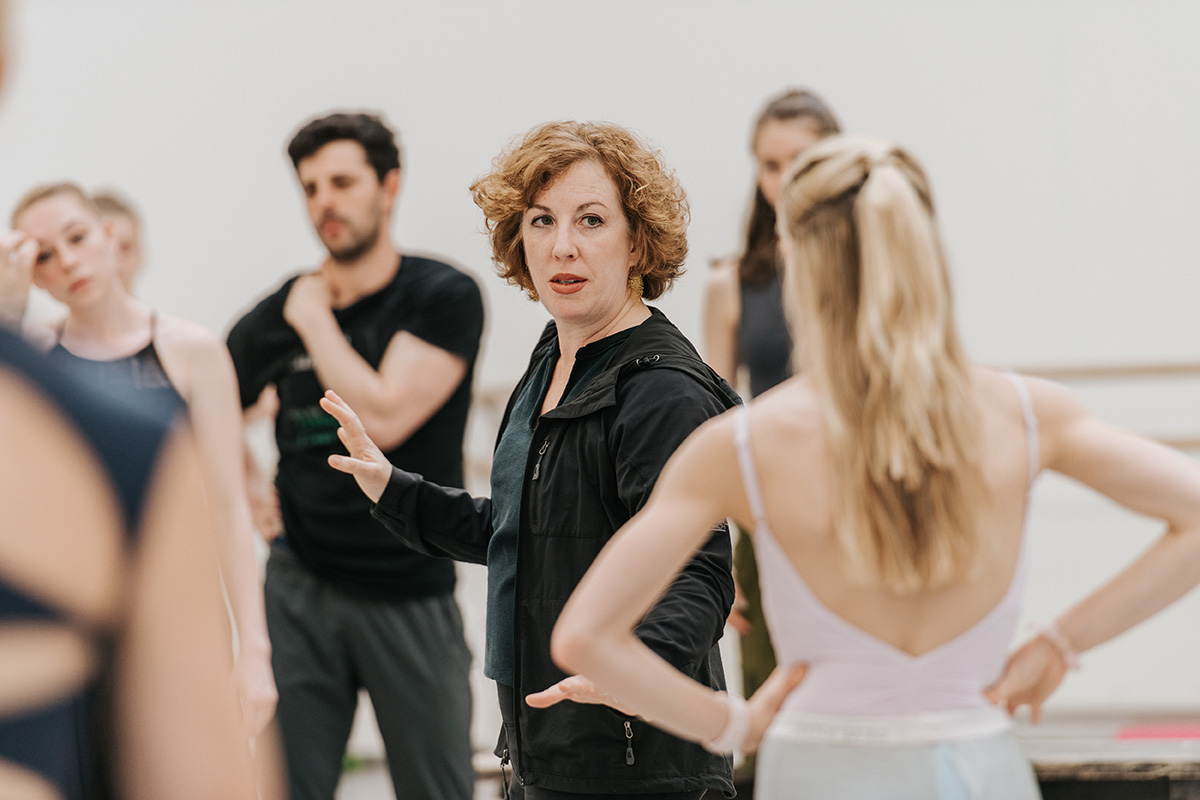June 1 to 3, Scottish Ballet presents The Crucible, an award-winning reimagining of Arthur Miller’s seminal play. This chilling account of the 1692 Salem witch trials recalls a community destroyed by hostility and hysteria—an allegory to the McCarthy hearings of the 1950s. As a ballet, Miller’s play is brought to life by choreographer Helen Pickett, one of today’s leading choreographers who works internationally, who has set more than 60 ballets for preeminent companies including American Ballet Theatre, Atlanta Ballet, Boston Ballet, West Australian Ballet, National Ballet of Canada, and Dutch National Ballet, among many others. For her full-length version of The Crucible, Pickett collaborated with director James Bonas, designers David Finn and Emma Kingsbury, and composer Peter Salem, who created a haunting new score—performed here by members of the Spoleto Festival USA Orchestra.
To learn more about the creation of this incredible work, Spoleto caught up with Pickett.
What is The Crucible’s origin story?
Christopher Hampson, the CEO/Artistic Director of Scottish Ballet, had invited me to create a few pieces for his company, including a one-act version of The Crucible in 2014. After that premiere, he suggested turning it into a full-length. I loved the potential in that, because for the one-act, I’d packed a lot of ideas into the first 45 minutes. A full-length gave me the opportunity to build on each character and the story.

So, how do you turn a play into a ballet? What is that process?
It begins with research, which I love when creating a new ballet. And even though I’m working from a set narrative, in this case a play, I write my own treatment. One can’t recreate each line of a play or a book—it’s just not possible. So, I create my own version, figuring out the beats that can be turned into dance and which characters to focus on.
In that research process, I read numerous articles about the time, saw a wonderful theatrical rendition of The Crucible by Ivo van Hove, and I went to Danvers, Massachusetts, which in the 1600s was called Salem Village and was the site of the trials. There, I went to the Rebecca Nurse Homestead, walked through her home, and walked into the graveyard. It was so chilling because the graveyard was full of Putnams, the enemies of the Nurses. At the homestead, I heard a fascinating talk about what historians think really might have happened to Abigail to shape her character. They believe she was suffering with PTSD after witnessing her parents being slaughtered. That made me think deeply about her humanity. Abigail wanted to belong to a family. In that moment, I knew I didn’t want to vilify her.
Can you share a bit about the other main characters in your version?
The center of my ballet is Abigail, Elizabeth Proctor, and John Proctor. Elizabeth is the most courageous character in the play. She doesn’t show all her cards. John is a complex character—but his cards are visible. We know about his choices and actions. Abigail is at once overt and covert, but she is a child and so she is transparent to the thinking adults—to the superstitious adults she is gospel. A problem.
In developing the treatment, James Bonas, my artistic partner, and I were interested in the stories that aren’t overt. The moments that aren’t really shown, but whispered about, are what I wanted to highlight with dance. For example, the dance in the forest and the prologue.
We set up the characters as humans in all their wonders and their failings; it helps the audience connect to them. I also wanted to set up a community within Salem—they worship together, they’re happy together. Then, when things start unraveling, the audience may have more empathy for the characters.

You mention community—what were other key themes that drove your creation of the work?
Courage. For me, that means facing reality in the moment and long term. Courage for your community, for yourself, and for your family. It’s sitting in a place that can be so scary and can unravel into terrible results—but you know it’s for the good. John Proctor agreed to have his name dragged through the mud and agreed to go to his death to save his wife. Elizabeth does the same thing. She knew John had had an affair, but she was sacrificing herself to save him. And Abigail is just a child—the town puts an incredible amount of power in the hands of people who should not have power. This play is so replete with social lessons that are pertinent today.
This play is seminal in American literature. When you were creating the work in Scotland, did those dancers have the same connection to the play as an American company might?
I had that same question. But the dancers told me that they read it in British schools, too, so they were absolutely familiar with it. The subject matter is very connected to Scottish history—there were witch trials and burnings there.

Your choreography is so sweeping, so full bodied, so intricate. How does that translate to Puritan characters? How did you think about their movement—or rather, their non-movement—style?
I focused the freedom of sweeping movement and freedom in the prologue, the dance in the forest, the affair between John Proctor and Abigail, the love duet between Elizabeth and John, and the solos of the townspeople.
Otherwise, the congregation, led by Reverend Parris, uses a very sharp, square, gestural vocab. Their movements are very musical, with one count for each arm movement. And as often as I could, I instructed the dancers’ eyes upwards, looking up in wonder. I also dubbed one group of characters the “Men of God”—including Reverend Parris, Reverend Hale, Ezekial Cheever, Marshall Herrick, Judge Hathorne, and Danforth—who use very hard edged, regimented, rhythmic, militaristic movement.
The second act opens with a rhythmic, almost ritualistic sequence when they’re filled with spirits. And there’s a moment when Abigail is really starting to lose her marbles and her movement gets very disjointed. The narrative provides a lot of direction.
Photos: Mihaela Bodlovic (top), and Jane Hobson

